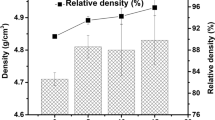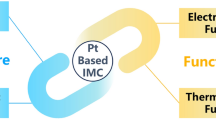Abstract
Suppressing sintering of supported particles is of importance for the study and application of metal-TiO2 system. Theoretical study of Ostwald ripening of TiO2(110)-supported Pd particles would be helpful to extend the understanding of the sintering. In this paper, based on density functional theory (DFT), the surface energy of Pd and the total activation energy (the sum of formation energy and diffusion barrier) of TiO2-supported Pd were calculated. Since the total activation energy is mainly contributed from the formation energy, it is indicated that the ripening of Pd particles would be in the interface control limit. Subsequently, the calculated surface energy and total activation energy were used to simulate Ostwald ripening of TiO2(110)-supported Pd particles. As a result, in comparison with larger particles, smaller particles would worsen the performance of ripening-resistance according to its lower onset temperature and shorter half-life time. The differences on ripening-resistance among different size particles could be mitigated along with the increase of temperature. Moreover, it is verified that the monodispersity can improve ripening resistance especially for the smaller particles. However, the different performances of the ripening originating from difference of the relative standard deviation are more obvious at higher temperature than lower temperature. This temperature effect for the relative standard deviation is the inverse of that for the initial main particle size. It is indicated that the influence of dispersity of TiO2(110)-supported Pd particles on ripening may be more sensitive at higher temperature. In this contribution, we extend the first principle kinetics to elaborate the ripening of Pd on TiO2(110). It is expected that the information from first principle kinetics would be helpful to the study in experiments.
Similar content being viewed by others
References
Diebold U. The surface science of titanium dioxide. Surface Science Reports, 2003, 48(5–8): 53–229
Chen M S, Goodman D W. The structure of catalytically active gold on titania. Science, 2004, 306(5694): 252–255
Valden M, Lai X, Goodman D W. Onset of catalytic activity of gold clusters on titania with the appearance of nonmetallic properties. Science, 1998, 281(5383): 1647–1650
Fu Q, Wagner T. Interaction of nanostructured metal overlayers with oxide surfaces. Surface Science Reports, 2007, 62(11): 431–498
Diebold U, Pan J-M, Madey T E. Ultrathin metal film growth on TiO2(110): an overview. Surface Science, 1995, 331–333(Part B): 845–854
Hu M, Noda S, Komiyama H. A new insight into the growth mode of metals on TiO2(110). Surface Science, 2002, 513(3): 530–538
Persaud R, Madey T E. Chapter 11 Growth, structure and reactivity of ultrathin metal films on TiO2 surfaces. In: King D A, Woodruff D P, eds. Growth and Properties of Ultrathin Epitaxial Layers. The Chemical Physics of Solid Surfaces, 1997, 8: 407–447
Park J B, Ratliff J S, Ma S, Chen D A. In situ scanning tunneling microscopy studies of bimetallic cluster growth: Pt–Rh on TiO2(110). Surface Science, 2006, 600(14): 2913–2923
Lei Y, Liu H, Xiao W. First principles study of the size effect of TiO2 anatase nanoparticles in dye-sensitized solar cell. Modelling and Simulation in Materials Science and Engineering, 2010, 18(2): 025004
Bartholomew C H. Mechanisms of catalyst deactivation. Applied Catalysis A, General, 2001, 212(1–2): 17–60
Moulijn J A, van Diepen A E, Kapteijn F. Catalyst deactivation: is it predictable? what to do? Applied Catalysis A, General, 2001, 212 (1–2): 3–16
Forzatti P, Lietti L. Catalyst deactivation. Catalysis Today, 1999, 52 (2-3): 165–181
McCarty J G, Gusman M, Lowe D M, Hildenbrand D L, Lau K N. Stability of supported metal and supported metal oxide combustion catalysts. Catalysis Today, 1999, 47(1-4): 5–17
Bugyi L, Óvári L, Kónya Z. The formation and stability of Rh nanostructures on TiO2(110) surface and TiOx encapsulation layers. Applied Surface Science, 2013, 280: 60–66
Piwoński I, Spilarewicz-Stanek K, Kisielewska A, Kądzioła K, Cichomski M, Ginter J. Examination of Ostwald ripening in the photocatalytic growth of silver nanoparticles on titanium dioxide coatings. Applied Surface Science, 2016, 373: 38–44
Madej E, Spiridis N, Socha R P, Wolanin B, Korecki J. The nucleation, growth and thermal stability of iron clusters on a TiO2(110) surface. Applied Surface Science, 2017, 416: 144–151
Jak M J J, Konstapel C, van Kreuningen A, Verhoeven J, Frenken J W M. Scanning tunnelling microscopy study of the growth of small palladium particles on TiO2(110). Surface Science, 2000, 457(3): 295–310
Stone P, Bennett R A, Poulston S, Bowker M. Scanning tunnelling microscopy and Auger electron spectroscopy study of Pd on TiO2(110). Surface Science, 1999, 433–435(2): 501–505
Stone P, Poulston S, Bennett R A, Bowker M. Scanning tunnelling microscopy investigation of sintering in a model supported catalyst: nanoscale Pd on TiO2(110). Chemical Communications, 1998, 13: 1369–1370
Howard A, Mitchell C E J, Egdell R G. Real time STM observation of Ostwald ripening of Pd nanoparticles on TiO2(110) at elevated temperature. Surface Science, 2002, 515(2 – 3): L504–L508
Su Y Q, Liu J X, Filot I A W, Hensen E J M. Theoretical study of ripening mechanisms of Pd clusters on ceria. Chemistry of Materials, 2017, 29(21): 9456–9462
Hansen T W, Delariva A T, Challa S R, Datye A K. Sintering of catalytic nanoparticles: particle migration or Ostwald ripening? Accounts of Chemical Research, 2013, 46(8): 1720–1730
Campbell C T. The energetics of supported metal nanoparticles: relationships to sintering rates and catalytic activity. Accounts of Chemical Research, 2013, 46(8): 1712–1719
Hu S, Li W X. Influence of particle size distribution on lifetime and thermal stability of Ostwald ripening of supported particles. ChemCatChem, 2018, 10(13): 2900–2907
Wynblatt P, Gjostein N A. Supported metal crystallites. Progress in Solid State Chemistry, 1975, 9: 21–58
Kang S B, Lim J B, Jo D, Nam I S, Cho B K, Hong S B, Kim C H, Oh S H. Ostwald-ripening sintering kinetics of Pd-based three-way catalyst: importance of initial particle size of Pd. Chemical Engineering Journal, 2017, 316: 631–644
Goldsmith B R, Sanderson E D, Ouyang R, Li W X. CO- and NO-induced disintegration and redispersion of three-way catalysts rhodium, palladium, and platinum: an ab initio thermodynamics study. Journal of Physical Chemistry C, 2014, 118(18): 9588–9597
Ouyang R, Liu J X, Li W X. Atomistic theory of Ostwald ripening and disintegration of supported metal particles under reaction conditions. Journal of the American Chemical Society, 2013, 135 (5): 1760–1771
Hu S, Li W X. Theoretical investigation of metal-support interactions on ripening kinetics of supported particles. ChemNanoMat: Chemistry of Nanomaterials for Energy, Biology and More, 2018, 4(5): 510–517
Wan Q, Hu S, Dai J, Chen C, Li W X. First-principles kinetic study for Ostwald ripening of late transition metals on TiO2(110). Journal of Physical Chemistry C, 2019, 123(2): 1160–1169
Vitos L, Ruban A V, Skriver H L, Kollár J. The surface energy of metals. Surface Science, 1998, 411(1 – 2): 186–202
Zhao C, Wan Q, Dai J, Zhang J, Wu F, Wang S, Long H, Chen J, Chen C, Chen C. Diluted magnetic characteristics of Ni-doped AlN films via ion implantation. Frontiers of Optoelectronics, 2017, 10 (4): 363–369
Parker S C, Campbell C T. Kinetic model for sintering of supported metal particles with improved size-dependent energetics and applications to Au on TiO2(110). Physical Review B, 2007, 75(3): 035430
Johnson C A. Generalization of the Gibbs-Thomson equation. Surface Science, 1965, 3(5): 429–444
Parker S C, Campbell C T. Reactivity and sintering kinetics of Au/TiO2(110) model catalysts: particle size effects. Topics in Catalysis, 2007, 44(1–2): 3–13
Kresse G, Furthmüller J. Efficient iterative schemes for ab initio total-energy calculations using a plane-wave basis set. Physical Review B, 1996, 54(16): 11169–11186
Kresse G, Furthmüller J. Efficiency of ab-initio total energy calculations for metals and semiconductors using a plane-wave basis set. Computational Materials Science, 1996, 6(1): 15–50
Kresse G, Hafner J. Ab initio molecular dynamics for liquid metals. Physical Review B, 1993, 47(1): 558–561
Feynman R P. Forces in molecules. Physical Review, 1939, 56(4): 340–343
Hammer B, Hansen L B, Nørskov J K. Improved adsorption energetics within density-functional theory using revised Perdew-Burke-Ernzerhof functionals. Physical Review B, 1999, 59(11): 7413–7421
Grant F A. Properties of rutile (titanium dioxide). Reviews of Modern Physics, 1959, 31(3): 646–674
Kim H Y, Lee H M, Pala R G S, Shapovalov V, Metiu H. CO oxidation by rutile TiO2(110) doped with V, W, Cr, Mo, and Mn. Journal of Physical Chemistry C, 2008, 112(32): 12398–12408
Henkelman G, Jónsson H. Improved tangent estimate in the nudged elastic band method for finding minimum energy paths and saddle points. Journal of Chemical Physics, 2000, 113(22): 9978–9985
Henkelman G, Uberuaga B P, Jónsson H. A climbing image nudged elastic band method for finding saddle points and minimum energy paths. Journal of Chemical Physics, 2000, 113(22): 9901–9904
Overbury S H, Bertrand P A, Somorjai G A. Surface composition of binary systems. Prediction of surface phase diagrams of solid solutions. Chemical Reviews, 1975, 75(5): 547–560
Zhao W, Lin H, Li Y, Zhang Y, Huang X, Chen W. Growth mechanism of palladium clusters on rutile TiO2(110) surface. Journal of Natural Gas Chemistry, 2012, 21(5): 544–555
Sanz J F, Márquez A. Adsorption of Pd atoms and dimers on the TiO2(110) surface: a first principles study. Journal of Physical Chemistry C, 2007, 111(10): 3949–3955
Kittel C. Introduction to Solid State Physics. New York: John Wiley & Sons, 1966
Lu H M, Li P Y, Cao Z H, Meng X K. Size-, shape-, and dimensionality-dependent melting temperatures of nanocrystals. Journal of Physical Chemistry C, 2009, 113(18): 7598–7602
Campbell C T, Parker S C, Starr D E. The effect of size-dependent nanoparticle energetics on catalyst sintering. Science, 2002, 298 (5594): 811–814
Acknowledgements
This work was supported by Key Project of Chinese National Development Programs (No. 2018YFB0406602), the National Natural Science Foundation of China (Grant No. 61774065). We thank Prof. W.-X. Li for fruitful discussions and S. Hu for the help of the ripening kinetics.
Author information
Authors and Affiliations
Corresponding author
Additional information
Qixin Wan received the B.E. degree from Nanchang University in 2004. He is currently pursuing the Ph.D. degree at Huazhong University of Science and Technology. His current research interest is nanomaterials and photoelectric materials.
Hao Lin received the B.E. degree from Wuhan University in 2014. He is currently pursuing the Ph.D. degree at Dalian Institute of Chemical Physics, CAS. His current research interest is crystal phase effects by first principles.
Shuai Wang received the B.E. degree from Huazhong University of Science and Technology in 2013. He is currently pursuing the Ph.D. degree at Huazhong University of Science and Technology. His current research interest is photoelectric device.
Jiangnan Dai received the B.E. degree from Hunan University of Science and Technology in 2002, and the Ph.D. degree from Nanchang University in 2007. Since 2010, he has been an associate professor at Huazhong University of Science and Technology, where he worked on photoelectric device based on wide bandgap semiconductor.
Changqing Chen received the B.E. degree from Wuhan University in 1992, and the Ph.D. degree from University of Erlangen-Nürnberg in 2000. Since 2007, he has been a professor at Huazhong University of Science and Technology, where he worked on lighting emitting diode.
Rights and permissions
About this article
Cite this article
Wan, Q., Lin, H., Wang, S. et al. Ripening-resistance of Pd on TiO2(110) from first-principles kinetics. Front. Optoelectron. 13, 409–417 (2020). https://doi.org/10.1007/s12200-019-0926-1
Received:
Accepted:
Published:
Issue Date:
DOI: https://doi.org/10.1007/s12200-019-0926-1




